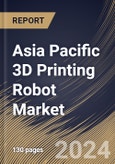These robots excel in producing customized and bespoke components. Whether it's patient-specific medical implants, individually tailored automotive parts, or personalized consumer goods, the technology enables the cost-effective creation of unique products at scale. Traditional manufacturing methods often face challenges when dealing with complex geometries and intricate structures. These robots overcome these limitations by layering materials in a controlled manner, allowing for the creation of lightweight yet durable components with previously unattainable geometries.
Moreover, in the healthcare sector, these robots have found extensive use in creating patient-specific implants, prosthetics, and dental appliances. The precision of the technology ensures a perfect fit, leading to improved patient outcomes. The aerospace industry benefits from the lightweight structures and intricate designs enabled by these robots. From engine components to complex aircraft parts, the technology offers a viable solution for the stringent requirements of this sector.
According to the International Trade Administration data, in terms of annual sales and manufacturing output, China remains the leading global producer of vehicles; domestic production is projected to attain 35 million units by 2025. Additionally, as per the India Brand Equity Foundation, FMCG sales in the country were expected to grow 7-9% by revenues in 2022-23. India’s fast-moving consumer goods (FMCG) sector grew 7.5% by volumes in the April-June 2023 quarter, the highest in the last eight quarters. Therefore, expanding FMCG and automotive sectors in Asia Pacific can lead to enhanced growth in the regional market.
The China market dominated the Asia Pacific 3D Printing Robot Market by Country in 2022, and would continue to be a dominant market till 2030; thereby, achieving a market value of $347.3 million by 2030. The Japan market is registering a CAGR of 14.9% during (2023 - 2030). Additionally, The India market would showcase a CAGR of 16.4% during (2023 - 2030).
Based on Component, the market is segmented into Robot Arms, 3D Printing Heads, and Software. Based on Application, the market is segmented into Prototyping, Tooling, and Functional Part Manufacturing. Based on Robot Type, the market is segmented into Articulated Robots, Cartesian Robots, Scara Robots, Polar Robots, Delta Robots, and Others. Based on End User, the market is segmented into Aerospace & Defense, Construction, FMCG, Culinary, Automotive, and Others. Based on countries, the market is segmented into China, Japan, India, South Korea, Singapore, Malaysia, and Rest of Asia Pacific.
List of Key Companies Profiled
- Kuka AG (Midea Group Co., Ltd.)
- ABB Group
- Yaskawa Electric Corporation
- FANUC Corporation
- Universal Robots A/S (Teradyne, Inc.)
- Massive Dimension
- CEAD B.V.
- Caracol
- Meltio3D
- Comau S.p.A. (Stellantis N.V.)
Market Report Segmentation
By Component- Robot Arms
- 3D Printing Heads
- Software
- Prototyping
- Tooling
- Functional Part Manufacturing
- Articulated Robots
- Cartesian Robots
- Scara Robots
- Polar Robots
- Delta Robots
- Others
- Aerospace & Defense
- Construction
- FMCG
- Culinary
- Automotive
- Others
- China
- Japan
- India
- South Korea
- Singapore
- Malaysia
- Rest of Asia Pacific
Table of Contents
Companies Mentioned
- Kuka AG (Midea Group Co., Ltd.)
- ABB Group
- Yaskawa Electric Corporation
- FANUC Corporation
- Universal Robots A/S (Teradyne, Inc.)
- Massive Dimension
- CEAD B.V.
- Caracol
- Meltio3D
- Comau S.p.A. (Stellantis N.V.)
Methodology

LOADING...








